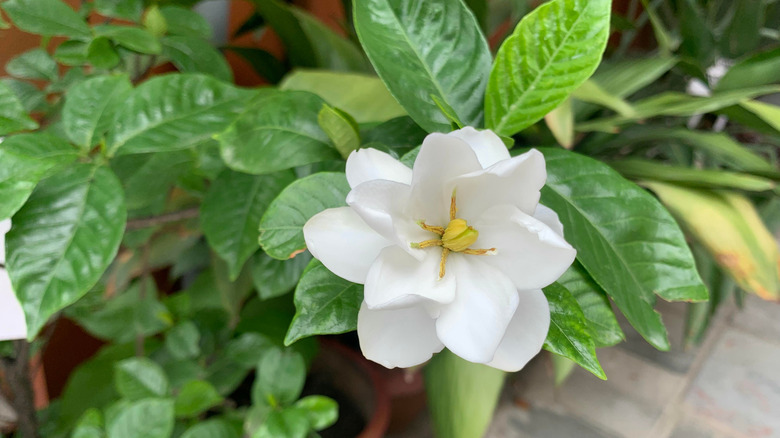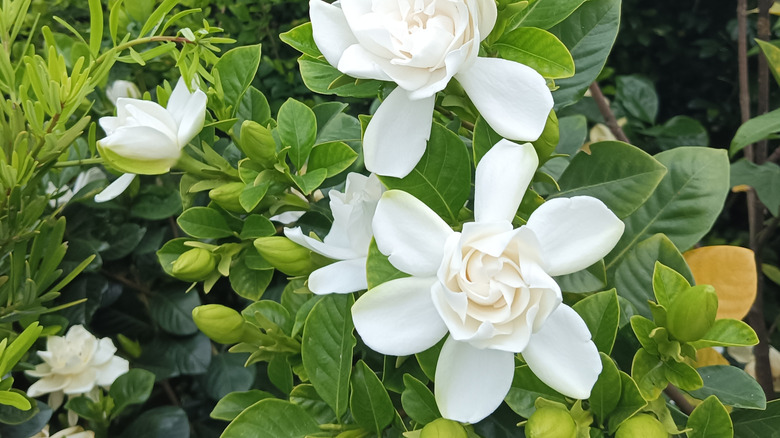Are Coffee Grounds The Secret Hack To Thriving Gardenias? Here's What We Know
We may receive a commission on purchases made from links.
Gardenias are extremely popular, yet notoriously hard to grow. The most common type of gardenia is Cape Jasmine (Gardenia jasminoides), known for its lovely strong scent, lush green leaves, and delicate white flowers. Like baking the perfect soufflé, or landing a date with a seemingly unattainable classmate, growing the perfect gardenia plant is all the sweeter because of the difficulty involved.
Gardenias are not native to the United States, and prefer the warm, humid, subtropical environments found in parts of Asia, Africa, Australia, and the Pacific Islands. They don't like extreme heat or extreme cold, preferring temperatures between 60 to 75 degrees (don't we all). They also need just the right soil conditions to flourish. Many people think a genius way to use leftover coffee grounds is to mix them into the soil to use as gardenia fertilizer. After all, coffee is acidic and filled with beneficial micronutrients.
However, spent coffee grounds actually have a neutral pH, and any nutrients left in the used grounds are scant at best. To get the best benefits from coffee, you'd need to use fresh grounds — not exactly a cost-effective solution. Used coffee grounds can benefit the soil and help repel pests, but like anything surrounding gardenia care, they need to be added in exactly the right way.
The right way to use coffee grounds to improve soil for gardenias
Coffee grounds should not be used in lieu of fertilizer, but you can use them to enrich the soil. The grounds feed the soil microbes, which promotes good soil structure and drainage. Add about a ½ inch of used coffee grounds to the growing medium at a depth of 4 inches or so. Make sure the grounds make up less than 20% of the soil's volume and wait two weeks before adding more grounds.
Spent coffee grounds can also act as a superb pest repellent when used as mulch. Cover the area around the gardenia's trunk with the grounds and water thoroughly. To keep the grounds from drying out and blocking water from reaching the roots, layer the top with leaves or bark mulch. Sprinkle coffee grounds on your yard and say goodbye to pests like slugs, snails, wasps, ants, and fleas. You can also create a soil drench using one part water and two parts brewed caffeinated coffee (a great way to use up what's left in the pot). If you find that your gardenia's leaves are being munched on by pesky slugs, add one part brewed caffeinated coffee to nine parts water and spray the mixture directly onto the leaves. Try spraying a sample leaf first and let it sit for a few days to make sure there's no damage.
Help gardenias thrive with the right soil conditions (and other care tips)
When taking care of gardenias, you need to pay close attention to the soil. Gardenias need well-draining soil that will keep moist but not wet. The soil should be highly organic and acidic, with pH levels around 5.0 to 6.0 (you can check pH levels with a soil tester like this SONKIR Soil pH Meter). Adding fertilizer is very important for cultivating healthy gardenias in the garden. Feed the gardenias once a month with an acidic fertilizer such as GARDENWISE 8-4-8 Acidic Fertilizer. Only fertilize during the growing months in spring and summer.
Most gardenias are hardy in USDA zones 8 to 11. However, some varieties (like the aptly named 'Frostproof') can tolerate the winters in zone 7. If you're in a colder climate, you can grow potted gardenias indoors.
Although they prefer tropical climates, these picky flowers also don't like extreme heat or too much direct sunlight. Plant gardenias in an area with all-day dappled sunlight, or direct sunlight for only two to six hours per day. Gardenias need roughly an inch of water per week, and the leaves should be spritzed with water in dry areas to mimic humidity. Their shallow roots need to be covered with mulch to keep them from getting too hot, too cold, or too dry. Growing gardenias is highly rewarding, but if you aren't up for misting leaves, checking soil pH, and making homemade coffee-based slug poison, you may want to stick with a low-maintenance flower like daylilies or geraniums instead.


